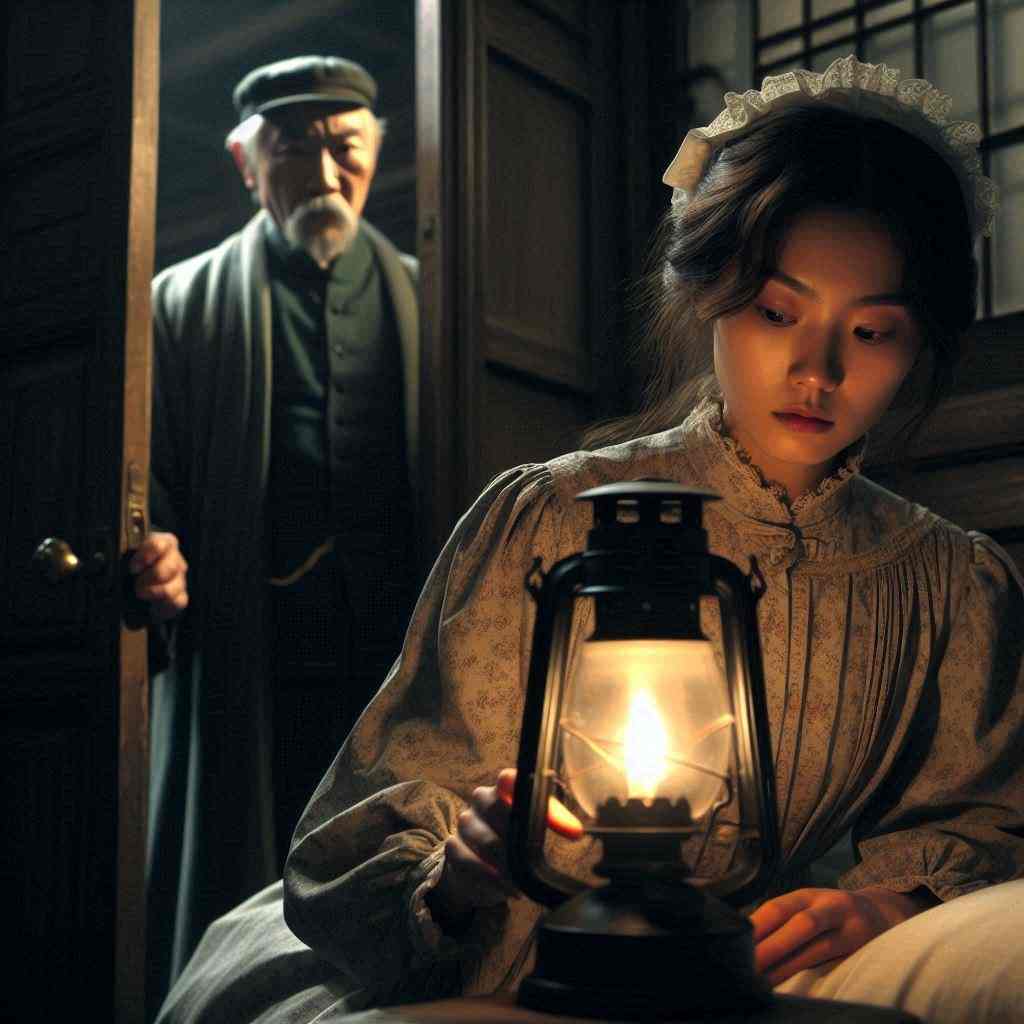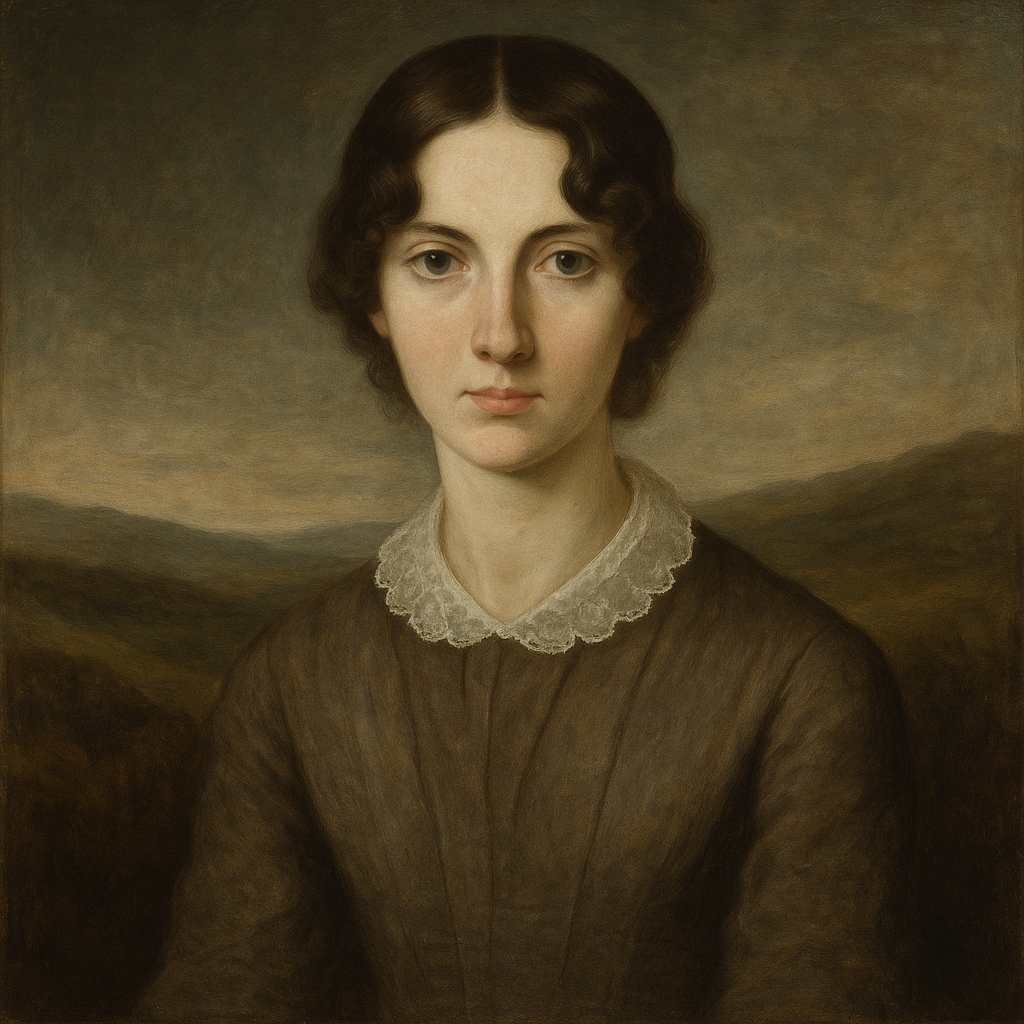The Visionary
Emily Brontë
1818 to 1848

Want to track your favorites? Reopen or create a unique username. No personal details are required!
Silent is the house: all are laid asleep:
One alone looks out o’er the snow-wreaths deep,
Watching every cloud, dreading every breeze
That whirls the wildering drift, and bends the groaning trees.
Cheerful is the hearth, soft the matted floor;
Not one shivering gust creeps through pane or door;
The little lamp burns straight, its rays shoot strong and far:
I trim it well, to be the wanderer’s guiding-star.
Frown, my haughty sire! chide, my angry dame!
Set your slaves to spy; threaten me with shame:
But neither sire nor dame nor prying serf shall know,
What angel nightly tracks that waste of frozen snow.
What I love shall come like visitant of air,
Safe in secret power from lurking human snare;
What loves me, no word of mine shall e’er betray,
Though for faith unstained my life must forfeit pay.
Burn, then, little lamp; glimmer straight and clear—
Hush! a rustling wing stirs, methinks, the air:
He for whom I wait, thus ever comes to me;
Strange Power! I trust thy might; trust thou my constancy.
Emily Brontë's The Visionary
Introduction
Emily Brontë's poem "The Visionary" is a masterful exploration of romantic longing, defiance, and the power of the imagination. Through its vivid imagery and carefully structured verses, the poem offers a window into the inner world of a passionate speaker, whose fervent anticipation of a secret lover challenges the constraints of her society. This analysis will delve into the poem's thematic richness, its use of symbolism and contrast, and its place within the broader context of Brontë's work and the Romantic tradition.
Setting and Atmosphere
The poem opens with a striking juxtaposition between the silent, sleeping household and the lone watcher who remains awake. This contrast immediately establishes a sense of isolation and heightened awareness that persists throughout the piece. The imagery of snow and winter creates a backdrop of cold sterility against which the speaker's warm passion stands in relief. Brontë's description of the "snow-wreaths deep" and "wildering drift" evokes a sense of both beauty and danger, mirroring the precarious nature of the speaker's situation.
The interior setting is described with equal care, emphasizing the comfort and safety of the home with its "cheerful hearth" and "soft matted floor." This cozy domesticity serves as a counterpoint to the wild, unpredictable exterior world, highlighting the tension between security and adventure that underpins the poem's emotional landscape.
Symbolism and Imagery
Central to the poem's symbolic structure is the "little lamp" that the speaker tends with such care. This lamp serves multiple functions within the text. On a practical level, it is a beacon for the expected lover, a "guiding-star" to light their way through the snowy waste. Symbolically, it represents hope, constancy, and the speaker's unwavering devotion. The act of trimming the lamp becomes a ritual of love and anticipation, a physical manifestation of the speaker's emotional investment.
The repeated references to watching and seeing—"looks out," "Watching every cloud," "prying serf"—create a sense of vigilance and secrecy that permeates the poem. This visual motif underscores the clandestine nature of the relationship and the speaker's hyperawareness of potential discovery.
Defiance and Rebellion
One of the most striking aspects of "The Visionary" is its spirit of defiance. The speaker directly challenges parental authority, addressing her "haughty sire" and "angry dame" with a boldness that borders on contempt. This rebellion against familial and societal expectations aligns the poem with the Romantic tradition's emphasis on individual freedom and emotional authenticity.
The speaker's willingness to risk "shame" and even to "forfeit pay" with her life for her "faith unstained" elevates her passion to the realm of the sacred. This conflation of romantic love with spiritual devotion is characteristic of Brontë's work and speaks to the all-consuming nature of the speaker's feelings.
The Supernatural Element
As the poem progresses, it takes on an increasingly otherworldly tone. The anticipated lover is described as a "visitant of air," possessed of "secret power" that protects them from "lurking human snare." This ethereal quality blurs the line between reality and fantasy, leaving open the possibility that the lover may be a figment of the speaker's imagination.
The final stanza's reference to a "rustling wing" and "Strange Power" further emphasizes this supernatural aspect. Whether the lover is meant to be understood as an angel, a spirit, or simply idealized by the speaker's fevered imagination, their otherworldly nature serves to elevate the romance beyond the mundane constraints of society.
Structural and Stylistic Elements
Brontë's use of rhyme and meter in "The Visionary" is worth noting. The poem follows a regular AABB rhyme scheme, which lends it a sense of order and progression that contrasts with its emotionally charged content. The predominantly iambic meter, with its rising rhythm, creates a sense of forward momentum that mirrors the speaker's anticipation.
The poem's four-stanza structure allows for a clear progression of ideas, moving from the physical setting to the speaker's defiance, then to the nature of her love, and finally to the moment of anticipated arrival. This careful organization belies the tumultuous emotions expressed within the verses, creating a tension between form and content that adds depth to the reading experience.
Themes of Isolation and Connection
Throughout "The Visionary," Brontë explores the interplay between isolation and connection. The speaker is physically alone, separated from her sleeping household and the outside world by walls and windows. Yet she feels profoundly connected to her absent lover, to the point where this spiritual bond seems more real and vital than her tangible surroundings.
This theme of isolation is common in Brontë's work, particularly in her novel "Wuthering Heights." In both the poem and the novel, characters find themselves at odds with society, seeking connection through unconventional and often supernatural means. The intensity of these desired connections serves to highlight the perceived emptiness of conventional relationships.
Feminist Interpretation
From a feminist perspective, "The Visionary" can be read as a powerful statement of female agency and desire. The speaker actively chooses her path, refusing to be cowed by threats or shame. Her passion is not a passive thing, but an active force that drives her to defy societal norms and familial expectations.
Moreover, the speaker's control over the narrative is significant. She alone knows the truth of her situation, wielding her secret knowledge as a form of power. This control over information, combined with her unwavering commitment to her chosen path, presents a portrayal of femininity that is far from the docile ideal of Victorian womanhood.
Conclusion
"The Visionary" stands as a testament to Emily Brontë's poetic skill and her unique vision. Through its vivid imagery, complex symbolism, and emotional intensity, the poem creates a world that is at once highly specific and universally relatable. It speaks to the human desire for connection, the allure of the forbidden, and the power of the imagination to transcend physical and societal limitations.
In its exploration of love, defiance, and the supernatural, "The Visionary" encapsulates many of the themes that define Brontë's body of work. It offers readers a glimpse into a passionate inner world, where the boundaries between the real and the imagined blur, and where the strength of one's convictions can stand against the combined forces of nature and society.
Ultimately, "The Visionary" is a poem about faith—faith in love, in the power of the individual will, and in the existence of forces beyond our understanding. It challenges us to consider the lengths to which we would go for our beliefs and the power of the human spirit to maintain hope even in the face of isolation and opposition. In doing so, it secures its place not only as a beautiful piece of poetry but as a profound exploration of the human condition.
This text was generated by AI and is for reference only. Learn more
Want to join the discussion? Reopen or create a unique username to comment. No personal details required!



Comments
No comments yet. Be the first to comment!